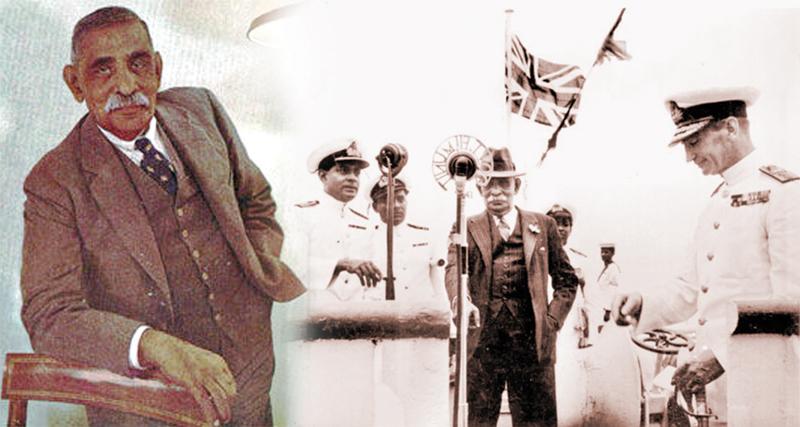
Don Stephen Senanayake or D. S. Senanayake, is respected by all Sri Lankans as the ‘Father of the Nation’. He served as the first Prime Minister of Sri Lanka, then known as Ceylon, from 1947 to 1952.
Birth
Don Stephen was born on October 21, 1884, to Don Spater Senanayake, who was a successful entrepreneur, and Dona Catherina Elizabeth Perera Gunasekera Senanayake, in the village of Bothale. Graphite mines were among Don Spater’s business interests.
Stephen had two elder brothers, Don Charles and Frederick Richard, both of whom also joined the Independence Movement.
Education
Though young Stephen was from a Buddhist family he attended S. Thomas’ College, Mount Lavinia (a Christian school). He excelled Iat cricket, playing in the annual Royal-Thomian Big Match.
After completing his studies, Stephen joined the Surveyor General’s Department as a clerk, but left after a short while. Later, he joined his brother Charles in managing their father’s businesses. Stephen introduced the relatively new crop of rubber to their plantations.
D. S. married Molly Dunuwila, in 1910. They had two sons, Dudley Shelton and Robert Parakrama. Dudley later succeeded his father as the Prime Minister of Ceylon.
World War I
When World War 1 broke out in 1914, Stephen joined the Colombo Town Guard along with his brothers. Charles, Stephen and Frederick were imprisoned during the 1915 Sinhala-Muslim riots without any charges, mainly to discourage other Sinhala protestors. After almost one and a half months in prison, the brothers were released on bail.
Stephen and Charles were prominent members of the Lanka Mahajana Sabha political party, while Charles and Frederick were committed to the development of the Young Men’s Buddhist Association. Stephen was active in the independence movement, mainly in support of Frederick.
Election to the Legislative Council
In 1924, Stephen was elected to the Legislative Council of Ceylon, which was the then equivalent of the Parliament, contesting from Negombo. Seven years later, he joined the new State Council of Ceylon representing his party, the Ceylon National Congress, and was appointed as the Minister of Agriculture and Lands.
During his tenure, D.S. Senanayake successfully combatted the country’s rice problems and shortages, and established the Land Development Ordinance. He was instrumental in establishing the Yala National Park, and the Bank of Ceylon.
During World War II, a Civil Defence Department was established in Ceylon. As a member of the Ceylonese War Council, Stephen played a vital role in the supply of food during the War. An example of the many defence programs undertaken by him is the rapid construction of an airfield at the Colombo Racecourse.
Leader of the House
In 1942, he became Leader of the House following Sir D.B. Jayatilleke’s retirement, Four years later, D.S. resigned from the National Congress, instead pushing for the independence of Ceylon.
In 1947, after India was granted independence, Senanayake saw a window to push for his case. After consideration by the new Colonial Secretary, Arthur Creech Jones, D.S. Senanayake’s proposals were accepted, and Ceylon was transformed from a colony into a dominion. The Ceylon State Council also embraced the ideas proposed by Senanayake.
In the Parliamentary Elections held during August and September 1947, he won the Mirigama seat. His party, the United National party,(UNP), didn’t obtain a majority of the votes but formed a government along with the All-Ceylon Tamil Congress.
First Prime Minister of Ceylon
In September of the same year, the Governor General of Ceylon, Sir Henry Moore, invited D. S. to form a Cabinet of Ministers as the first Prime Minister. Later in December, the ‘Independence Bill of Ceylon’ was passed, and on February 4, 1948, Ceylon marked its independence with the ceremonial opening of Parliament.
The Independence Ceremony of Ceylon
After becoming Prime Minister Senanayake expanded the policies he had during his career as Minister of Agriculture. He planned the increase of food production to make Ceylon a self-sustainable nation. He boldly made plans to tackle this issue, and His Gal Oya scheme relocated over 250,000 people. D. S. laid the basis for Ceylon’s foreign relations with the outside world, being the Minister of External Affairs.
He also established the Armed Military Forces of the Nation. He refused a Knighthood, but maintained good relations with Britain. On the morning of March 21, 1952, D. S. Senanayake was taking his usual horse ride before breakfast, on the Galle Face Green when he suddenly fell off the saddle unconscious. He was rushed to the National Hospital in Colombo.
Doctors believed that the Prime Minister had suffered a stroke. DS Senanayake died at 3:30 pm on March 22, 1952.
Dinara Hettiarachchi
Grade 8
Ananda College Colombo 10.
